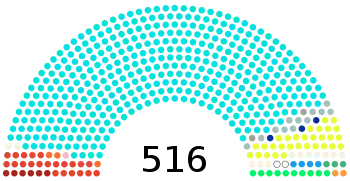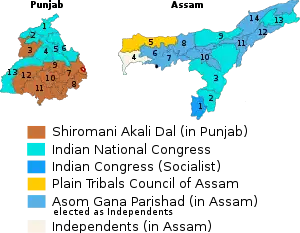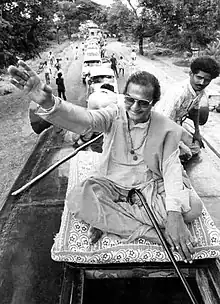| |||||||||||||||||||||||||||||||||||||
541 of the 543 seats in the Lok Sabha 271 seats needed for a majority | |||||||||||||||||||||||||||||||||||||
|---|---|---|---|---|---|---|---|---|---|---|---|---|---|---|---|---|---|---|---|---|---|---|---|---|---|---|---|---|---|---|---|---|---|---|---|---|---|
| Registered | 400,375,333 | ||||||||||||||||||||||||||||||||||||
| Turnout | 64.01% ( | ||||||||||||||||||||||||||||||||||||
| |||||||||||||||||||||||||||||||||||||
 Results by constituency | |||||||||||||||||||||||||||||||||||||
| |||||||||||||||||||||||||||||||||||||
| This article is part of a series on the |
| Politics of India |
|---|
 |
|
|
General elections were held in India in 1984 soon after the assassination of previous Prime Minister, Indira Gandhi, though the vote in Assam and Punjab was delayed until 1985 due to ongoing fighting.
The elections were a landslide victory for the Indian National Congress of Rajiv Gandhi (son of Indira Gandhi), which won 404 of the 514 seats elected in 1984 and a further 10 in the delayed elections. The Telugu Desam Party of N. T. Rama Rao, a regional political party from the state of Andhra Pradesh, was the second largest party, winning 30 seats, thus achieving the distinction of becoming the first regional party to become a national opposition party. Voting was held immediately after the assassination of Indira Gandhi and the 1984 anti-Sikh riots in November and most of India supported Congress.
The 1984 elections were the last in which a single party won a majority of seats until 2014, and the only time to date in which a party won more than 400 seats.
Results
 | ||||
|---|---|---|---|---|
| Party | Votes | % | Seats | |
| Indian National Congress | 115,478,267 | 49.10 | 404 | |
| Bharatiya Janata Party | 18,202,853 | 7.74 | 2 | |
| Janata Party | 16,210,514 | 6.89 | 10 | |
| Lokdal | 14,040,064 | 5.97 | 3 | |
| Communist Party of India (Marxist) | 13,809,950 | 5.87 | 22 | |
| Telugu Desam Party | 10,132,859 | 4.31 | 30 | |
| Communist Party of India | 6,363,430 | 2.71 | 6 | |
| Dravida Munnetra Kazhagam | 5,695,179 | 2.42 | 2 | |
| All India Anna Dravida Munnetra Kazhagam | 3,968,967 | 1.69 | 12 | |
| Indian Congress (Socialist) | 3,577,377 | 1.52 | 4 | |
| Indian National Congress (Jagjivan) | 1,511,515 | 0.64 | 1 | |
| Revolutionary Socialist Party | 1,173,869 | 0.50 | 3 | |
| All India Forward Bloc | 1,055,556 | 0.45 | 2 | |
| Jammu & Kashmir National Conference | 1,010,243 | 0.43 | 3 | |
| Indian Union Muslim League | 658,821 | 0.28 | 2 | |
| Kerala Congress (Joseph) | 598,113 | 0.25 | 2 | |
| Doordarshi Party | 508,426 | 0.22 | 0 | |
| Peasants and Workers Party of India | 463,963 | 0.20 | 1 | |
| Jharkhand Mukti Morcha | 332,403 | 0.14 | 0 | |
| Kerala Congress | 258,591 | 0.11 | 0 | |
| All India Muslim League | 224,155 | 0.10 | 0 | |
| Gandhi Kamraj National Congress | 217,104 | 0.09 | 0 | |
| Socialist Unity Centre of India | 196,767 | 0.08 | 0 | |
| Republican Party of India (Khobragade) | 165,320 | 0.07 | 0 | |
| Manipur Peoples Party | 149,019 | 0.06 | 0 | |
| Tamil Nadu Congress (K) | 144,076 | 0.06 | 0 | |
| Naga National Democratic Party | 113,919 | 0.05 | 0 | |
| Jammu & Kashmir Panthers Party | 95,149 | 0.04 | 0 | |
| Maharashtrawadi Gomantak Party | 83,122 | 0.04 | 0 | |
| People's Party of Arunachal | 78,455 | 0.03 | 0 | |
| Republican Party of India | 22,877 | 0.01 | 0 | |
| Jharkhand Party | 18,837 | 0.01 | 0 | |
| Jammu & Kashmir Peoples Conference | 646 | 0.00 | 0 | |
| Independents | 18,623,803 | 7.92 | 5 | |
| Appointed Anglo-Indians | 2 | |||
| Total | 235,184,209 | 100.00 | 516 | |
| Valid votes | 235,184,209 | 97.49 | ||
| Invalid/blank votes | 6,062,678 | 2.51 | ||
| Total votes | 241,246,887 | 100.00 | ||
| Registered voters/turnout | 379,540,608 | 63.56 | ||
| Source: ECI | ||||
Delayed elections in Assam and Punjab

The elections in Punjab were held in September 1985 after the signing of the Rajiv–Longowal Accord between Prime Minister Rajiv Gandhi and Akali leader Harchand Singh Longowal on 24 July 1985. The elections were held alongside elections to the Punjab Legislative Assembly.[1] In Assam elections were held in December 1985 after the signing of the Assam Accord in August 1985.[1]
| Party | Votes | % | Seats | |
|---|---|---|---|---|
| Indian National Congress | 4,628,777 | 32.14 | 10 | |
| Shiromani Akali Dal | 2,577,279 | 17.90 | 7 | |
| Communist Party of India (Marxist) | 462,576 | 3.21 | 0 | |
| Indian Congress (Socialist) | 457,705 | 3.18 | 1 | |
| Communist Party of India | 369,687 | 2.57 | 0 | |
| Plain Tribals Council of Assam | 310,150 | 2.15 | 1 | |
| Bharatiya Janata Party | 263,284 | 1.83 | 0 | |
| Janata Party | 420,082 | 2.92 | 0 | |
| Lokdal | 46,627 | 0.32 | 0 | |
| Independents | 4,864,958 | 33.78 | 8 | |
| Total | 14,401,125 | 100.00 | 27 | |
| Valid votes | 14,401,125 | 95.70 | ||
| Invalid/blank votes | 646,951 | 4.30 | ||
| Total votes | 15,048,076 | 100.00 | ||
| Registered voters/turnout | 20,834,725 | 72.23 | ||
| Source: ECI | ||||
See also
References
- 1 2 Narain, Iqbal (1986). "India in 1985: Triumph of Democracy". Asian Survey. 26 (2): 253–269. doi:10.2307/2644461.
.jpg.webp)

_1.jpg.webp)


